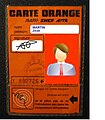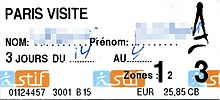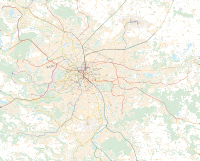Public transport fares in the Île-de-France

Public transport fares in the Île-de-France are set using a system of concentric fare zones radiating from central Paris, and are implemented with a mixture of paper and electronic tickets. Prices are determined by the regional autorité organisatrice de transports ("Regional Transport Organisational Authority"), which for Île-de-France is Île-de-France Mobilités.
History[]
This section needs expansion. You can help by . (November 2011) |
In 1900, a second-class Paris Métro ticket cost 15 centimes of the old franc, and a first-class ticket 25 centimes. In 1960, it cost 37 centimes of the new franc.[Note 1] Six hundred million Métro tickets were sold that year, an average of around 1,500 a minute.[1]

Tramway tickets issued by the Compagnie Est Parisien ("Eastern Paris Company") (before 1921)

Métro tickets issued by the Compagnie du chemin de fer métropolitain de Paris (CMP) ("Paris Metropolitan Railway Company") (1900 – 1945)
Carnet of bus tickets from the Société des transports en commun de la région parisienne (STRCP) ("Paris region public transport society") (1921 – 1948)

First design of the Carte Orange (1975)
First class was abolished in 1991 on the Métro,[2] and in 1999 on the rest of the railway network in the Île-de-France.[3]

MP 59 in 1964: first class in yellow and second class in blue

MS 61 in 1982: First class section with yellow detailing
Zones[]
The zonal system[]

The fare zones were put in place after the ticket fare structure had been decided. These concentric zones, numbered 1 to 8 (until 1 July 2007), are centred on Paris, with , the most central, covering the commune of Paris, surrounding it, and so on. is the most distant from the centre, and was only used in the south-east of the Île-de-France.
On 1 July 2007 the zones were reduced to six, with and 8 being absorbed into .[4] At its board meeting of 8 December 2010, the STIF voted to remove Zone 6, absorbing it into from 1 July 2011.[5][6] On 1 July 2011, zone 6 is absorbed into .
Towards a flat fare[]
The reduction in the number of fare zones is a preamble to a potential flat rate fare from June 2012, a manifesto commitment following negotiations between the Socialists and Green parties during the 2010 regional elections. However, a monthly fare of €65,[vague] announced by the Greens during their campaign, would have the STIF lose €550m, which cannot be done while continuing with necessary infrastructure investment. The STIF thus suggested possible fares of €79 or €89, which would balance the books.
But according to a study by the think-tank Mentras, published in January 2011, although 310,000 ticket-holders for zones 1-5 and 1-6[Note 2] would see their travel costs reduce, a flat fare would harshly hit 1,249,000 season ticket holders in Paris and its inner suburbs, and even in the outer suburbs 162,000 would suffer, as well as others who use a two-zone ticket.[7]
On 11 February 2015, the STIF voted the creation of the Navigo "all zones", available from 1 September 2015 for a price of €21.25 weekly, €70 monthly, €770 yearly. Navigo for zones 2-3, 3-4 and 4-5 will remain available at their current price. The fare structure of day passes (Mobilis, Paris visite, ticket jeunes) remains unchanged.[8]
Implementation[]
Inclusive tickets (daily, weekly and monthly) are valid for a given set of zones, and may be used on all modes of transport within them. For example, a passenger having a ticket for zones 2 to 4 can travel freely within those zones, but must purchase a separate ticket covering the portion of any journey that goes outside these zones, for example into zone 1 or zone 5. The extra ticket can be loaded onto the Navigo card as well. However, tickets valid for a month or longer can be used in any zone on weekends and public holidays without additional payment.
Paper tickets (with magnetic strips) must be validated by inserting them into a machine whereby a date and time is punched onto the strip. Some tickets have limited validity thereafter, so that a journey must be completed within a certain time after validation. Navigo passes are contactless smart cards and are validated by presenting them near to an RFID reader. Fines are issued for those travelling without a valid ticket.
Over six million paper tickets are sold each week, an average of 1,500 a minute. Each ticket weighs 0.5 grams (0.018 oz).[9][10]
Demagnetisation[]
According to the RATP, ticket demagnetisation affects 0.5% of tickets sold. Such tickets can be exchanged free of charge at a point of sale. Even with the small failure rate, this figure means at least 300,000 tickets are exchanged just by the RATP. To reduce this figure, the RATP has started issuing newer, stronger tickets with a better-protected magnetic strip, replacing the magnetic tape with iron bands. This ticket will come into general use by the end of 2011.[11]
Ticket types[]

The STIF sells several kinds of ticket. Single tickets are intended for occasional passengers. Combination and season tickets are aimed at regular travellers and those touring the region, and can be bought for various periods of validity.
Single tickets[]
For occasional journeys, tickets for one journey may be purchased singly or, slightly more cheaply, in booklets ("carnets") of ten. The carnets of 10 are usually the best option for tourists as well. As one only takes the Metro 3-4 times a day, the combined price of carnet tickets at €1.45 per ticket is much lower than day passes (€7.30). They can also easily be used among groups as they are transferable.
Ticket "t+"[]

(above: obverse; below: reverse)
The Ticket "t+" is the most basic ticket in the Île-de-France. It is a paper ticket that allows one journey on the Métro, the tramways, the bus network and services run by Optile, a conglomerate of suburban bus operators. As of August 2021 it costs €1.90 or in a carnet of 10 for €16.90, with children and other entitled users paying half-price for a carnet[12] and can be used on several modes of transport, with one or more interchanges. The time from the first validation of the ticket to the last must not exceed 90 minutes. However, it cannot be used to interchange between a Métro or RER line and the bus or tramway, nor between a Métro line and the Montmartre funicular. The carnet of paper tickets will cease to be sold in 2022, but users of Navigo can purchase 10 single journeys for €14.90 – unlike carnet tickets, these cannot be shared between multiple travellers.[13]
Île-de-France ticket[]
The billet Île-de-France ("Île-de-France ticket"), sometimes called the billet origine-destination, is a paper ticket that allows for a point-to-point journey between two stations in the Île-de-France region served by either suburban Transilien or RER trains. The fare depends on the distance travelled. It can be used in either direction between origin and destination, and allows the use of the Noctilien night bus network run by Transilien SNCF. The fare depends on the origin, destination and route and there are two fares: full fare or reduced fare. One can buy a single ticket or a carnet of ten, at a reduction of 20% on the single ticket price. There is no limit to how far in advance a ticket can be purchased before being validated, but once validated they are valid for 2 hours only.
Combination and season tickets[]
[]

Navigo is a smartcard on which season tickets valid for a week, a month, or a year may be loaded. Weekly tickets are valid from Mondays to Sundays. They are sold from the Friday of the week before. Monthly tickets are valid from the first to the last day of the calendar month. They are sold from the 20th day of the previous month. Annual tickets are sold for 12 calendar months. On purchase, a combination of two adjacent zones or all five zones must be chosen. For a journey to be valid the ticket must include all zones from the origin to the destination, including all zones passed through (even if no interchange is made there), although on weekends monthly and annual tickets may be used as though they covered all five zones. The ticket can be used for any number of journeys on any form of public transport in the region. Prior to 2009, carte orange with accompanying magnetic tickets were sold for this purpose.
Navigo cards may also load 1-day tickets (similar to Mobilis) for any combination of two, three, four, or five zones, or 10 single journeys equivalent to t+ tickets.
Carte Intégrale[]
La Carte Intégrale is a yearly (renewable) season ticket. For year-round travellers, it provides a saving of about 2 months compared to the monthly Carte orange.[14] Once the ticket is purchased at an RATP or SNCF office, it is valid as long as the purchaser renews it each month. The ticket comes with an "Advantage card" which allows discounts at major retailers. The ticket is only available on a Navigo pass. During 2011 the Carte Intégrale will change its name to the "Yearly Navigo" (French: forfait Navigo annuel).
Carte Imagine'R[]
The Carte Imagine'R is a ticket for students between 12 and 25 years of age. Valid for a year, it can be used on all modes of public transport in the region. Mondays to Fridays it can be used only in the zones assigned to the ticket, but at weekends and during public and school holidays the zones are relaxed and it can be used throughout the region. It also acts as a discount card in many large retailers and at other attractions.
Mobilis[]

Mobilis is an all-day ticket comprising a number of zones (1–2, 1–3, 1–4 and 1–5) with unlimited travel within them. It does not allow travel to Paris-Charles de Gaulle Airport or Paris-Orly Airport, for which a Paris Visite ticket or a separate airport ticket is required (Charles de Gaulle Airport is in ). The Mobilis ticket is issued as a paper ticket indicating the zones for which it is valid. It is not transferable, and to validate them passengers must write their full names on the tickets before using them, together with the date.
Ticket Jeunes[]
The Ticket Jeunes ("Young Persons Ticket") was an all-day discount ticket for those under 26 years of age. It can be used only on Saturdays, Sundays and public holidays, within the zones indicated on the ticket: 1–3, 1–5, or 3–5. It allows unlimited travel within the ticketed zones, on the bus, Métro, tramway, RER and main-line train, except for the Orlyval, Orlybus, Roissybus and access to Charles de Gaulle Airport via RER B, Allobus, routes operated by Le Bus Direct, and tourist buses. Tickets including zone 1 can be used throughout the Métro, even those parts outside zone 1.
It was issued as a paper ticket with a magnetic stripe, on which must be written the passenger's full name and the date of use. It is about half the price of a Mobilis ticket covering the same area.
The Ticket Jeunes was withdrawn from sale on 20 December 2019.
Paris Visite[]

The Paris Visite is an all-day ticket with four periods of validity: one, two, three or five consecutive days. It allows unlimited travel within the chosen zones (1–3 or 1–5) on all modes of transport – except the at Charles de Gaulle Airport, tourist buses, and Le Bus Direct services – and allows travel to Charles de Gaulle and Orly airports.[15]
The traveller's name and the dates of validity must be written on the ticket before use. This replaces the separate credit-card sized "name card" which was previously issued with the ticket. Amongst other things it offers discounts at some museums and monuments in the Île-de-France. It is aimed particularly at tourists[15] — but in many cases, Mobilis is cheaper.
Specialized tickets and discount cards[]
Carte Améthyste[]
The Carte Améthyste is a discount card for the elderly and the disabled (aged over 20).[Note 3] It allows free travel on all modes of transport throughout the Île-de-France.
Carte Solidarité Transport[]
The Carte Solidarité Transport is a discount card for those in great need, those on sickness benefits, those on unemployment benefits, single parents, and those earning the Revenu minimum d'insertion (RMI, a minimum earnings guarantee).[16] It provides a discount of 50% on single tickets and 75% on monthly and weekly Carte orange tickets. The carte has a validity of one year and is intended for those in receipt of benefits. It is only available on demand, and exclusively by telephone (on a free call) through the agency.
Moreover, residents receiving Revenu de solidarité active (RSA, a form of social welfare) can use all of the road and rail network for free (except the Orlyval). Since 1 December 2008 this has also applied to those receiving the , another benefit. Beneficiaries of RMI must renew their pass every three months, and the credits are automatically assigned to a Navigo pass or at a charging station.
Fares[]
Since 1 November 2019, the fares for ticket t+ are:
- Ticket "t+": sold individually, €1.90
- Sold on board buses: €2.00
- Carnet of 10 tickets: €16.90 — carnets can be purchased for half-price for use by children under 10 as well as various groups such as the disabled, war veterans, and large school groups.
"Origin - Destination" tickets (those priced according to distance travelled), sold both singly and in carnets, vary depending on distance travelled. For most journeys, a carnet of ten tickets – which are valid in either direction – costs the same as eight individual tickets.
A monthly Navigo covering all zones costs €75.20
See also[]
Notes[]
References[]
- ^ "Tout ce qu'il faut savoir sur le ticket de métro" [Everything you need to know about Métro tickets] (in French). Le Parisien. 4 November 2010. Retrieved 8 November 2011.
- ^ "Abolition de la 1er classe dans le métro" [Abolition of first class on the Métro] (in French). French Senate. 5 December 1991. Retrieved 8 November 2011.
- ^ "Matériel Roulant du RER" [RER rolling stock] (in French). symbioz.net. Retrieved 8 November 2011.
- ^ "Réduction des tarifs : le fin des zones 7 et 8" [Fare reductions: The end of zones 7 and 8] (PDF) (Press release) (in French). STIF. 13 December 2006. Archived from the original (PDF) on 5 April 2012. Retrieved 11 November 2011.
- ^ "Ile-de-France : la zone 6 disparaît sur le Pass Navigo" [Ile-de-France: zone 6 will disappear from the Navigo pass] (in French). Le Parisien. 8 December 2010. Retrieved 11 November 2011.
- ^ "Conseil du 8 décembre 2010, Budget 2011, Fusion des zones Navigo 5 et 6" [Meeting of 8 December 2010, fusion of Navigo zones 5 and 6] (PDF) (Press release) (in French). STIF. 8 December 2010. p. 2. Archived from the original (PDF) on 5 April 2012. Retrieved 11 November 2011.
- ^ "Ile-de-France : le Navigo à tarif unique pénaliserait 1,4 million d'usagers" [Ile-de-France: the flat-fare Navigo will hurt 1.4m users] (in French). Le Parisien. 25 January 2011. Retrieved 11 November 2011.
- ^ STIF Press release, 11 February 2015
- ^ "Ticket de métro : repères" [Métro ticket: statistics] (in French). Le Parisien. 28 December 2010. Retrieved 11 November 2011.
- ^ Thonnat, Georges (28 October 2010). Petite histoire du Ticket de métro parisien [A brief history of the Paris Métro ticket] (in French). Télémaque. ISBN 978-2-7533-0114-6.
- ^ "De nouveaux tickets à la RATP pour éviter la démagnétisation" [About the new RATP tickets that reduce demagnetisation] (in French). Le Parisien. 28 December 2010. Retrieved 11 November 2011.
- ^ "Ticket t+". Retrieved 31 July 2021.
- ^ https://www.sortiraparis.com/news/in-paris/articles/171669-books-of-10-paris-subway-tickets-to-disappear-from-2022/lang/en
- ^ "Carte Intégrale, abonnement carte intégrale, tarifs et zones carte intégrale" (in French, Spanish, and English). Transilien. Archived from the original on 6 November 2011. Retrieved 11 November 2011.
Note: The website automatically detects the browser language. Some information is not available in the English version. - ^ Jump up to: a b "Paris Visite : presentation" (in English, French, German, Spanish, Dutch, and Japanese). RATP. Retrieved 11 November 2011.
- ^ "La tarification sociale dans les transports urbains, la mise en œuvre de l'article 123 de la loi SRU" (PDF) (Press release) (in French). Conseil général des ponts et chaussées. August 2006. Retrieved 11 November 2011.
External links[]
- "RATP Transports en île de France : Ticket types and fares" (in French). Retrieved 11 November 2011.
- Île-de-France Institute of Town and City Planning: Eléments de réflexion (December 2006):
- "1. Analyse de la composition socio-démographique des zones carte orange" [Analysis of the socio-demographic composition of the Carte orange fare zones] (in French). Île-de-France Institute of Town and City Planning. December 2006. Archived from the original on 25 April 2012. Retrieved 11 November 2011.
- "2. Relations entre tarification spatiale et morphologie urbaine" [Relations between spatial fares and urban morphology] (in French). Île-de-France Institute of Town and City Planning. December 2006. Archived from the original on 25 April 2012. Retrieved 11 November 2011.
- "3. Effet de la mobilité résidentielle sur les budgets transport et logement des ménages franciliens" [Effect of mobile populations on transport budgets and planning in the île-de-France] (in French). Île-de-France Institute of Town and City Planning. December 2006. Archived from the original on 25 April 2012. Retrieved 11 November 2011.
- Transport in Île-de-France






